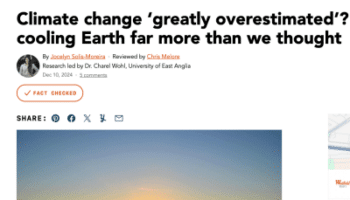- Climate
Daily Wire article incorrectly claims climate models have overestimated warming
Key takeaway
Climate models have, in fact, successfully projected the rate of global warming, comparing well with observed global temperature in recent years. The idea that models should be faulted for not predicting the "hiatus"—the period in the early 2000s during which temperatures stayed below the long-term trend—reflects a misunderstanding of what a model projection is.
Reviewed content

Verdict:
Claim:
climate models have overestimated the amount of global warming and failed to predict what climatologists call the warming ‘hiatus’
Verdict detail
Factually inaccurate: Observed temperatures have actually stayed within the range of model projections.
Misleading: Climate model projections show average long-term trends—by nature they will not "predict" short-term variability such as the "hiatus" period.
Full Claim
climate models have overestimated the amount of global warming and failed to predict what climatologists call the warming ‘hiatus’, over 20 years of almost no change in temperatures.

Professor, University of Exeter
Except that the report (the paper published in Nature Geoscience) never said that. The paper does not describe modelled warming vs. observations over the “hiatus” period.

Principal Research Fellow, National Centre for Atmospheric Science
Recent media headlines have again discussed the issue of whether climate models are overly sensitive to greenhouse gases. These headlines have misinterpreted a study by Millar et al. which was discussing carbon budgets to limit global temperature rise to 1.5°C above pre-industrial levels.
A recent study by Medhaug et al. analysed the issue of how the models have performed against recent observations at length and largely reconciled the issue. An overly simplistic comparison of simulated global temperatures and observations might suggest that the models were warming too much, but this would be wrong for a number of reasons.
In the Medhaug et al. paper they show the range of models (blue shading in figure with median in light blue), compared with the HadCRUT4 observations and their estimated uncertainty (orange shading with light orange line). There are a number of well understood reasons why the light orange line might not follow the light blue line, namely: radiative forcings, variability, observational biases and choice of reference period. [Read more…]

Figure 5 from Medhaug et al. showing CMIP5 simulations and observations (HadCRUT4) of global temperature.
- Medhaug et al (2017) Reconciling controversies about the ‘global warming hiatus’, Nature

Research Fellow, University of New South Wales
[This comment comes from an evaluation of a similar statement.]
For one example, this study by Rahmstorf and colleagues* shows how projections from past IPCC reports (future projections starting in 1990 and 2000) very well predicted the observed temperature changes since then.

Figure – Observed annual global temperature, unadjusted (pink) and adjusted for short-term variations due to solar variability, volcanoes and ENSO (red) compared to the scenarios of the IPCC (blue range and lines from the third assessment, green from the fourth assessment report). Source: Rahmstorf et al (2012)
- Rahmstorf et al (2012) Comparing climate projections to observations up to 2011, Environmental Research Letters

Professor, ETH Zürich
[This comment comes from an evaluation of a similar statement.]
Statements that climate models overestimate the warming in response to CO2 are incorrect; they are based on either too short time periods that are dominated by natural variability, by the comparison of models with datasets that do not have global coverage, by comparing to models that were run many years ago with emissions and forcings that differed from what actually happened, by the use of oversimplified energy balance models1, or a combination of these. Recent studies have shown that once the changes in climate feedbacks over time2, datasets with full coverage3, and all forcings are considered, the agreement between predicted and observed warming is excellent, even over the recent hiatus period4.
It is remarkable that even projections made decades ago with climate models that were much simpler (and were running on computers that were likely slower than a mobile phone today) were quite accurate5,6,7.
- 1- Knutti and Rugenstein (2015) Feedbacks, climate sensitivity and the limits of linear models, Philosophical Transactions of the Royal Society A
- 2- Armour (2017) Energy budget constraints on climate sensitivity in light of inconstant climate feedbacks, Nature Climate Change
- 3- Richardson et al (2016) Reconciled climate response estimates from climate models and the energy budget of Earth, Nature Climate Change
- 4- Medhaug et al (2017) Reconciling controversies about the ‘global warming hiatus’, Nature
- 5- Stouffer and Manabe (2017) Assessing temperature pattern projections made in 1989, Nature Climate Change
- 6- Fischer and Knutti (2016) Observed heavy precipitation increase confirms theory and early models, Nature Climate Change
- 7- Allen et al (2013) Test of a decadal climate forecast, Nature Geoscience



